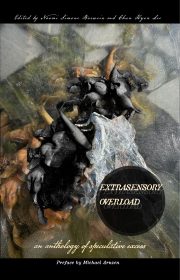How to Make Your Next SFF Work’s Currency
By John Dale Beety
What do your characters spend? Currency, the forms of money used in a setting, can add rich and suggestive detail to your worldbuilding. Here are eight key questions to answer when creating fictional currency.
Does Your Setting Need Currency?
Not necessarily! The word “money” shows up only twice in Andy Weir’s The Martian. Currency is irrelevant to the protagonist’s lonely struggles.
Because currency is a technology, your setting may not have developed it, using barter instead. Alternatively, post-scarcity societies can render currency obsolete.
Who Issues It?
While governments usually make and issue currency, other options exist.
Individuals and businesses make private currency, often to fulfill needs governments fail to meet. Religious bodies have issued currency for tithing and other practices. Magic: The Gathering’s Orzhov Syndicate combines these phenomena: their alms-coins function like company scrip.
Other currencies aren’t issued by central authorities, but are based on consistent rulesets, such as Bitcoin and other cryptocurrencies.
Who Trusts It?
A currency’s issuer says it is worth a certain amount. Do others believe that?
Many early coins were commodity money, assuring users that they contained a specific amount of a precious metal, such as the equivalent of 8.1 grams in a gold croeseid of Lydia. Merchants sometimes tested coins and stamped their own approval on them.
Later developments in currency require more trust. Representative money, not worth anything itself but redeemable for something valuable, arose in China a millennium ago. More recently, fiat currencies rely solely on their issuer’s reputation.
People spend currency they distrust and hoard currency they do trust, as described by Gresham’s Law. Loss of trust can lead to hyperinflation, ruining a currency’s value in days or even hours. In Neal Stephenson’s Snow Crash, trillion-dollar United States notes are near-worthless. This may seem exaggerated, but real-world hyperinflation once reached the quintillions in Hungary.
Where Does It Spend?
Use of currency often transcends borders, especially in trade. El Salvador no longer issues its own currency; its two legal tenders are United States dollars and Bitcoin. The Masquerade of Seth Dickinson’s The Traitor Baru Cormorant use “paper currency in their Falcrest tongue” as tools of conquest.
Other nations restrict or disallow free exchange of their currencies. Currencies may even be traps used to steal victims’ wealth, like the banknotes issued by the Nazis during the Holocaust.
What Are the Units?
Currency unit names often reflect sources of power, inspirations, and previous currencies. The colonial Spanish real (“royal”) led to currency names as far-flung as the Cambodian riel, Saudi riyal, and Brazilian real. The credit is the real’s impersonal, futuristic cousin. Botswana’s “pula” means rain, a precious resource. The Bohemian Joachimsthaler became “thaler” and then “dollar”.
Decimal denominations are common today, but relatively recent. For example, J. K. Rowling’s 29 bronze Knuts per silver Sickle and 17 Sickles per gold Galleon in the Wizarding World put a prime-number spin on the British pre-decimalisation system of twenty pennies per shilling and twelve shillings per pound, retired in 1971.
Denominations can become obsolete. Due to inflation, several Eurozone countries round prices to the nearest five cents, with one- and two-cent coins not in daily use. On the opposite end, the European Central Bank discontinued the 500-euro note in part because it “could facilitate illicit activities.”
What Appears On It?
Images and text on currency reflect the issuer’s values.
Classical Greek coinage often depicted patron deities, such as Helios on coins of Rhodes. A ruler’s head is both a portrait and a national symbol. Other recurring symbols include plants, animals, and mythological creatures.
Common currency text includes the issuer, denomination, date, and mottos. Text may be almost invisible (coded messages, security microprinting) or dominate a design, as on calligraphic Mughal coinage.
What Are the Materials?
Only a few metals accessible to classical civilizations proved suitable for coinage. The “gold-silver-bronze” trio emerged because all three were soft enough to strike as coins, yet durable enough to last in commerce. Advancing technology has allowed for other coinage metals, such as nickel, aluminum, and steel.
Early Chinese banknotes used fibers from hemp and paper mulberry bark. Federal Reserve Notes of the United States use a cotton-linen blend. Since the 1980s, polymer or “plastic” banknotes have spread worldwide for their greater durability and anti-counterfeiting potential.
Digital currencies, made of pure information, have evolved from science fiction (such as Cory Doctorow’s Whuffie) to fact. Other SFF currencies’ materials are replicator-resistant or magically verifiable.
Currency needs reliable material supplies, and breakdowns can yield great worldbuilding details. In the 1600s, after Sweden lost control of silver sources, it issued massive “plate money” ingots of copper, which it had in abundance. War and economic emergencies have led to currencies made of porcelain and leather, among other materials.
How Is It Made?
The making of physical currency affects its visual, aural, and tactile qualities.
Most coins are struck: a blank goes between two dies, and force squeezes them together, imprinting the coin’s image on the blank. For much of history, hammered coinage, made by hand with a literal hammer, was the norm. Machine-struck, or milled coinage, emerged in the late Renaissance. Hammered coinage often has irregular edges, while milled coinage has the regular shapes familiar today.
Cast coins also exist, most notably Chinese “cash” or qian. Casting allowed for iron coinage centuries before industrialized steel. Cast coins also sound different from struck coins; struck coins ring when tapped together (hence “ring true“), while cast coins “clunk”.
Paper banknotes generally use engraved plates for intaglio printing, with offset printing a recent addition for Federal Reserve Notes. Polymer banknotes can also use intaglio printing, as in Australia, to give a note its textured “feel.”
SFF settings offer many more currency-making techniques, from nanomanufacturing to The Stormlight Archive’s gems embedded in glass and beyond. Whatever fits a setting’s rules is fair game.
Answer these key questions with your setting’s available technologies and materials in mind, use your imagination, and you will create the perfect currency for your next work!
 John Dale Beety (he/him) is a copy editor for a gaming strategy site and a former coin expert for an auction house. His first game writing client was Wizards of the Coast, using up all of his authorial luck points in a single throw. Due to an incident aired on national television, he holds a lifelong grudge against the long-dead department store magnate Rowland Hussey Macy.
John Dale Beety (he/him) is a copy editor for a gaming strategy site and a former coin expert for an auction house. His first game writing client was Wizards of the Coast, using up all of his authorial luck points in a single throw. Due to an incident aired on national television, he holds a lifelong grudge against the long-dead department store magnate Rowland Hussey Macy.


